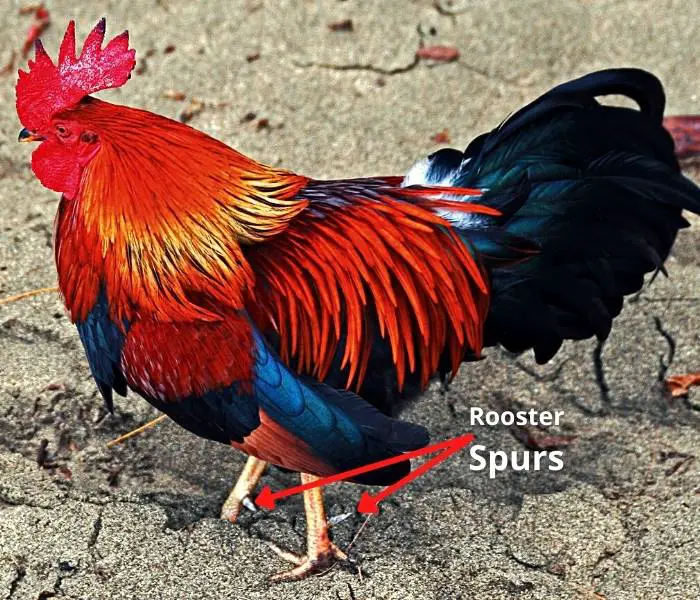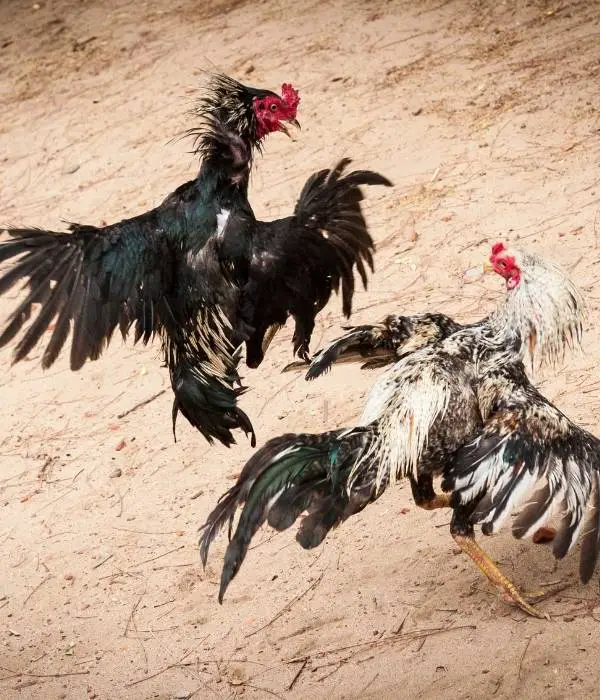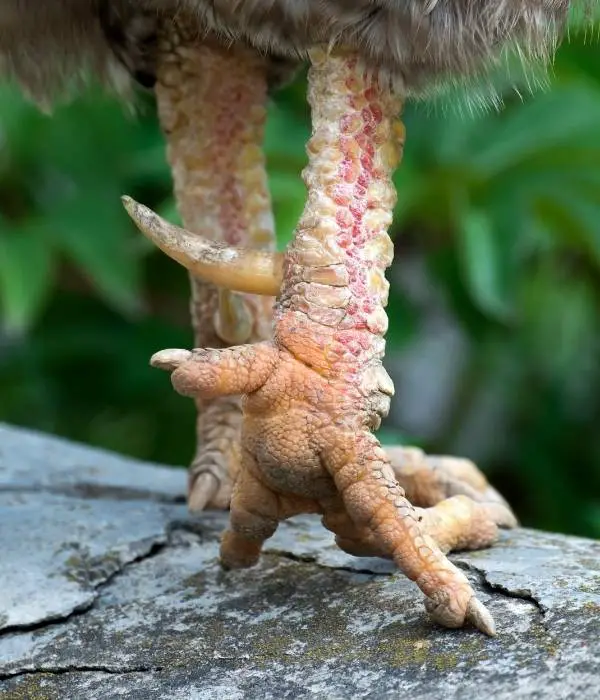
Do you want to know all about rooster spurs? You may have noticed the long, sharp spurs on their feet.
Rooster spurs are not just for looks: they have an important function in the life of a rooster. Rooster spurs protect from predators like hawks, raccoons, and dogs. They also use them in territorial fights.
This article will discuss rooster spurs- what they are when they develop, why they are there, and how to remove them.
You will also get answers to some common questions about rooster spurs, so if you’re curious about these prickly features on your rooster, read on!
What Are Rooster Spurs?
Rooster spurs are sharp, pointy growths that protrude from the backs of chickens’ legs.
These spurs are part of the leg bone, except that they are covered with keratin, a hard material found in the beaks of chickens and rhino horns.
The spurs keep growing as the rooster matures; some even curl and develop a sharp tip. These spurs can be quite dangerous, and roosters with particularly large or sharp spurs should be handled carefully.
Roosters use these spurs as weapons to protect their flock from predators or anything that seems threatening. They also use these spurs in fighting over food and territory.
Also read: Hen vs. Rooster
When Do Rooster Spurs Develop?

Spurs develop on all chickens, both hens, and roosters. This small bump at the back of the shank stays dominant in hens without growing.
It, however, keeps growing in roosters, especially when the bird reaches sexual maturity, which is usually around six months of age.
The size and sharpness of the spurs can vary greatly from one rooster to another. These spurs sometimes grow excessively and become too long to hinder the roosters’ walks. If that happens, they should be trimmed.
Why Do the Roosters Have Spurs?
Wondering why roosters have something so sharp on their bodies? There are crucial reasons they exist other than to let you know they’ve got a rooster on their heads.
So why exactly do they have these sharp spurs?
Protection
The main purpose of a rooster’s spur is to help him defend his flock from impending danger. In the wild, roosters with large and sharp spurs are more likely to survive and pass on their genes than those without.
If a predator like a dog or a cat threatens the flock, the rooster puffs up its feathers, makes many noises, and attacks the predator with its sharp spur. The spur’s hardness, sharpness, and thickness are enough to secure the flock from danger.
Pecking order
If you have several roosters, ensure that they have enough hens. If the hens are few, there certainly will be some bloodshed.
Roosters use these spurs as a weapon to attack other roosters. Based on the pecking order, the roosters can fight each other to death or scare the secondary rooster into being submissive.
Can You Remove Rooster Spurs?
Yes, it is possible to remove a rooster’s spurs. Even though rooster spurs are essential, they might cause some damage to the roosters’ legs if they keep growing.
They tend to curl back on themselves if left untrimmed for long. You can remove them temporarily by clipping, trimming, or permanently through surgery.
Removing the spurs permanently can be a good choice, but its downside is the high costs and risks involved. If you choose to remove them permanently, make sure a veterinarian does it.

How to Remove Rooster Spurs?
If you have decided to remove your rooster’s spurs, it is necessary to understand a few things. First, choose a method you want to use and prepare accordingly.
Second, if you go for complex procedures, ensure you know what you are doing. If not, seek the help of a qualified veterinarian.
Spurs can be removed surgically filing, clipping, or using oil, pliers, or potatoes.
1. Surgery
If you want to remove the spur permanently, the surgical procedure is the best. Whereas you can do this procedure by yourself, it is not recommended.
This method can cause pain to your rooster and, in some cases, cause permanent damage to the legs. The surgery can also fail in so many ways, so you should seek help from the experts.
2. Clipping spur or trimming spur
Spurs consist of keratin, a component found in human nails. You will clip the spur just like your nails when they grow long.
The only difference here is that you will use a guillotine-style nail clipper instead of a nail cutter. You might also need some powder to stop the bleeding.
- Podiatrist Toenail Clippers: New sharp curved blade...
- Sharp & Durable: Podiatrist professional toenail...
- Upgraded Double Spring: Upgraded no spring or single...
- Updated Handle Nail Nipper: made with ABS material that...
- One Year Promise: Free refund or replacement during the...
Last update on 2024-07-12 / Affiliate links / Images from Amazon Product Advertising API
- Hold the rooster in place and ensure that it has settled. If it is not moving too much, keep holding it in place, ensuring you are not hurting it.
- Examine the spur in a well-lighted area to differentiate the sheath from the bone.
- Clip the spur, taking caution not to clip the bone. This will be painful to the rooster and can cause some permanent damage.
- There might be some bleeding after clipping. So you will take cornstarch or any blood-stop powder and put it where it is bleeding. The bleeding usually occurs if you cut too deep into it.
- Effective blood coagulant that works to stop severe...
- Non-breakable plastic container with shaker top for...
Last update on 2024-07-12 / Affiliate links / Images from Amazon Product Advertising API
3. Filing
Since spurs have keratin, you can use a metal file to file the spur. This method is safe, but it takes quite some time.
- You will need to hold your rooster in place.
- Once you have secured it and have settled, take your file and start filing.
- Keep filing until you reach the bone.
- FLAT FILE – The WORKPRO W051002 Flat File has an...
- DURABLE – This 10 inch file features durable, precise...
- ANTI-SLIP GRIP – It is constructed of high carbon...
- DEBURR ITEMS – You can also use this file to deburr...
- MULTIPURPOSE TOOL – This file is a great multipurpose...
Last update on 2024-07-12 / Affiliate links / Images from Amazon Product Advertising API
To save time, some people combine filing with clipping. They clip the spur to a part that won’t hurt, then make their way down using a file.
4. Potato method
I know this method sounds unusual, but it’s one of the safest and most popular. It is also quite efficient, and just as its name suggests, you will need some potatoes.
You will also need gloves and pliers to complete the method. You will also need some blankets or towels if you do it yourself.
So, to remove spurs with the potato method:
- Heat a potato in the microwave for a few minutes until it cooks.
- ii. Safely hold your rooster in place. If you are doing it alone, take your blanket or towel and wrap it around your rooster to calm it down. Do not forget to leave one leg at a time out.
- If you have someone to help, ask them to hold the rooster where you see the spur.
- Take the potato from the microwave and stick it to your rooster spur carefully, ensuring that it does not touch the leg. This prevents the hen from getting burned.
- Take the pliers and twist the spur to one side and then to the other side. Twist several times until the spur pops off the leg. If the pliers don’t hold the spurs well, use your hands without forgetting to put gloves on.
- COMFORT AND CONTROL: Multi-zone bi-material grips of...
- STRENGTH AND DURABILITY: Pliers are made from...
- PRECISION MACHINED JAWS: For secure gripping and...
- Precision machined jaws for gripping, and holding
Last update on 2024-07-12 / Affiliate links / Images from Amazon Product Advertising API
5. Oil method
The oil method is similar to the potato method. It has the same steps, only that you will use oil instead of potatoes here.
The other difference in these methods is that there will be no heat involved in the oil method, making it much safer.
This method, however, will take a bit of time compared to the potato method. In the latter, the heat softens the keratinous part of the spur, making it easier to remove.
6. Pliers method
The pliers’ method is similar to the potato and oil methods, only that you will skip softening the spur. Twist the spur till it pops off the leg.
Other FAQs

1. How to treat a rooster spur injury with bleeding?
Injuries will happen at some point. It might be from fighting predators or just something mysterious. If your rooster has an injury on the spur, this is what you need to do
a) Clean your hands
Once you discover the injury, access it to determine the extent of the damage. If it is bleeding, you will need to stop it first with a styptic powder or any blood-stop powder.
Cornstarch or baking flour can be used if you don’t have any other option. Allow the powder to clot and dry up, then clean it.
b) Cleaning the wound
You will need to clean the wound to prevent infection. Some old soap and warm water is a good and gentle method. Ensure you rinse it off with Dawn Dish Soap.
Do not forget to clean the surrounding area of the wound too. Rinse it in a sink without drenching the rooster if you want a larger scrap.
A full bath is unnecessary as it will stress them; just ensure it’s wet enough to eliminate all germs and dirt.
c) Applying treatment
Now it’s time to treat the wound. There are several ways you can achieve that. Some of them include:
Raw honey: Raw honey is known for its excellent antibacterial properties that speed up wound healing. Just spread some on the wound and separate the rooster from the flock.
Hydrogen peroxide or alcohol: Hydrogen peroxide is an excellent antiseptic for treating minor cuts, scrapes, and burns in chicken.
Applying it to puncture wounds is not recommended. Just take a cotton ball and apply the hydrogen peroxide onto the wound.
Blue Kote: Blue Kote has antiseptic and fungicidal wound healing properties. It is suitable for wounds and abrasions. It has a Gentian Violet antiseptic dye that dyes the injury a dark blue color.
This dye helps cover up the wound and prevent pecking from other birds. Wear gloves to avoid dying your hands blue when spraying the area.
Neosporin: Neosporin is another good choice to treat injuries, as long as it doesn’t have any painkillers. Just apply it to the wound and rub gently.
2. Do my chickens need rooster spur gloves?
- SAFE & GENTLE FOR PET :Good fighting gloves for injury...
- HANDMADE PRODUCT: Product of thailand make by Thai...
- FOR FIGHTING GAME ROOSTER : Fighting Game Rooster...
- CONDITION NEW QUANTITY :1 set = 2 pair : (4 sides)...
- 100% SATISFACTIONGUARANTEED : Safe and gentle on your...
Last update on 2024-07-12 / Affiliate links / Images from Amazon Product Advertising API
They don’t, but you might want to consider getting chicken gloves if you are handling them often. Their nails are pretty sharp and can injure you when handling them.
3. How to stay safe from a rooster spur attack?
The Rooster spurs’ sharpness might cause some injury. To stay safe from an intended attack, do this:
- The Roosters give a warning before attacking. They will lower their heads and dance, looking at you. If you notice this, avoid walking straight toward it or staring at it. You should also avoid creeping around. This shows the rooster that you are scared.
- Always have gloves on, a long-sleeved shirt, long, strong pants, and farm boots for protection. You can feed the rooster with your hands to get it used to you. It is best if you don’t bend down near it if it is very aggressive.
- Roosters fight with their legs, so you can roll him over with your foot when he attacks. Keep rolling him until he gives up. Ensure that you have boots on.
- When he attacks, scoop him up and clamp him under your arm for up to 30 minutes until he calms down. Release him if he squawks and repeat the clamping until he calms down.
- You can take something with you to protect yourself from the attack when going to the coop.
4. Will roosters’ spurs grow back?
Yes, they will grow back, but not as sharp as before. Spurs will take some time, maybe after maybe six weeks, to grow back, so in the meantime, you can trim them down with nail clippers.
5. Are rooster spurs poisonous?
No, they aren’t poisonous. However, if you are handling the roosters often, you might want to consider getting chicken gloves.
- EXCELLENT BITE PROOF: RAPICCA Leather Animal Handling...
- SUPERIOR SECURITY FOR FORERAMS - The 16 inches extra...
- THICK AND DURABLE - RAPICCA Leather Animal Handling...
- USED By: Veterinarians, Animal Control Staff, Groomers,...
- MULTI - FUNCTION FOR MEN & WOMEN - They are not only...
Last update on 2024-07-12 / Affiliate links / Images from Amazon Product Advertising API
Final words
That’s all there is to know about rooster spurs. Rooster spurs are essential for the flock as long as they are well maintained.
If roosters suddenly turn aggressive, assess what could be the reason and resolve it by ensuring that they have enough hens, a clean coop, food, water, shelter, and safety.
I hope this guide helped you learn all about rooster spurs and their needs.








Leave a Reply